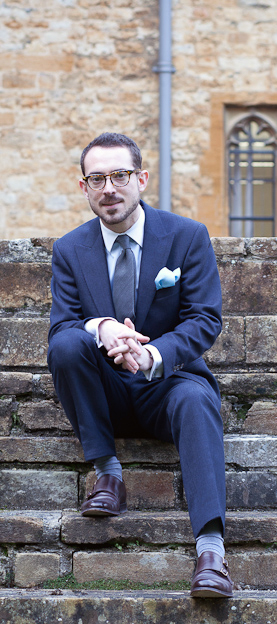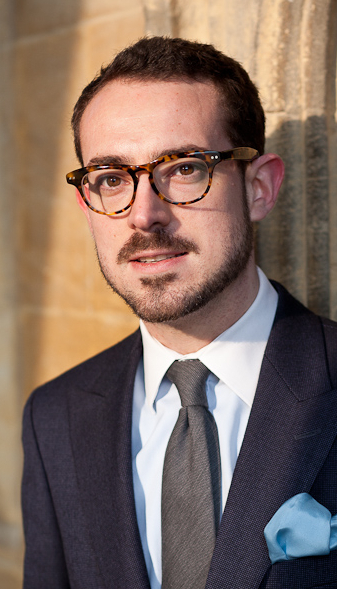Interview with Benjamin Wild
0March 26, 2013 by Ville Raivio
‘At the time of writing, I am three weeks short of D-Day, my thirtieth birthday. I am single and really want a dog, although numerous people have said this may not be a good idea. I was educated at King’s College London, where I studied history, for a very long time. If memory serves, I started my single honours history degree in 2001. Three years later, I started my Masters in medieval history and one year after this, I started my doctoral thesis, which involved transcribing and analysing the household accounts of King Henry III, England’s fourth-longest reigning monarch. The household accounts, which are written in a heavily abbreviated Latin cursive, are really interesting documents. Truly. They are the main source to tell us about Henry III’s personal expenses, which cover everything from building projects and food to jewellery and dress. I was, and remain, interested in the accounts for what they reveal about the material culture of the royal court. This has been the focus of my subsequent academic publications, which have considered the social and political meaning of (royal) jewellery, textiles and clothing.
Products from Pukimo Raivio
Ralph Lauren, Black Label suit, size 52EU
Initially, I think, family, friends and colleagues thought my focus on the ‘frilly bits’ of the past was frivolous, especially as I was a politically trained male historian. For a male historian to be interested in dress was, for some reason, ever-so-slightly taboo. But I don’t think people were that surprised by my academic leaning. I heard recently from a friend that somebody I used to know at university, and whom I have since lost contact with, recalled that I was ‘quirky’ and ‘well dressed’. So, I suppose people came to realise that my study of the history of dress was natural, if not inevitable. That is how I came to think of it, anyway.
When I was young(er), my first love was art. The open secret is that it really still is. I used to love drawing and painting, and would spend many afternoons sketching make-believe worlds and designing luxury cars. I paint and draw now, when time permits, and some of my creations hang in my apartment. But art was never respectable enough for a career. Apparently. So I was dissuaded, subtly but surely, to focus on a subject with more gravitas. This was how History, my second love, became my first choice for university. It was during my time at King’s, studying history and being surrounded by so many beautiful buildings, exhibitions and interestingly dressed people (in the main) that I began to realise that my passions for art and history were not mutually exclusive. Most people would have probably written a study of Henry III’s household accounts that focused on finance and administration. That would have been obvious, easy and sensible. I did cover these areas, but my work really centres on ceremony and art, although I still wish I could have gone further down this route. I’m not sure that I am completely happy with the published book. I am now working on something for Palgrave Macmillan, but it is hard going. I am not nearly as disciplined and organised as people think – working long hours and being slightly OCD tends to mask my inefficiencies.
My decision to write about contemporary (men’s) style and dress on the web is undoubtedly connected to my university studies and academic writing, but the decision to start Linleywild can be dated very precisely to a lunch date with a close friend last September. My tendency to view the present through the lens of the past, which is the theme that links all of the articles on my site, is almost instinctive. As I have had more suits made for me, I suppose I began to reflect more critically on the comparisons and juxtapositions between contemporary and classic styles. Thinking about the cut of a lapel, making the decision about whether to have jetted pockets or no pockets, a double- or single-breasted waistcoat, a pleated or plain trouser front, cannot but make you think about past vogues, the few men who got it right and the multitude who did not. The design process also made me think more about representation and semiotics, about the reasons why people dress the way they do. I shall explore these ideas further in the guest lectures that I will deliver at the Condé Nast Vogue College of Fashion and Design, which opens in London in April. I am chuffed to be involved in this exciting venture, if only in a relatively minor way.
But does all this mean I have a style? I’m not sure. There are certain details that all of my suits must have: Jacket = side vents; working cuffs; two-buttons; Waistcoat = five buttons; Trousers = no belt-loops; no front pleats and no turn-ups. Much of my Look, if I can even call it that, is determined by the fact that I am colour blind. I do not like to wear many colours, although I do like colours with strong contrasts. My suit colours are blue, brown or grey, or a combination thereof. I prefer white, pale blue or pale pink shirts. My ties, usually woollen or knitted silk, are plain, but bold in colour, and I frequently coordinate them with my socks.
As a child, I remember reading Hergé’s Tintin and Edgar Pierre Jacob’s Blake et Mortimer and being totally seduced by the colour choices. A poster of Hergé’s On A Marché Sur La Lune hangs in my study. I love the orange space suits with red and cobalt blue detailing. These colours really shouldn’t go. But they really do. The accent colours in my sitting room are orange and purple. The colour of one of my suits is blue (tweed) and orange (lining). So I think it would be fair to say that the bold and flat colours in these comics remain an inspiration. I like to think my choice for bold and flat colours works because the effect is combined with, and softened by, different textures. I like to wear tweed suits with linen or silk pocket squares and woven silk or woollen ties. The mixture of textures creates depth and interest. But again, my sartorial choice is shaped by the fact that I am colour blind. I cannot always rely on my perception of colours to identify things, so I focus on texture instead. My Look therefore becomes personal because it is shaped by my foibles, rather than by any force of will. The only thing I do use to check myself is a colour wheel, which is tacked up in my study.
I have friends who semi-religiously follow the edicts of Alan Flusser, Hardy Amis or Simom Crompton, but I do not. I have never sought to fold my pocket squares into the ‘Astaire’, ‘Cagney’ or ‘Winged Puff’ and I would struggle to name the variety of shirt collars. To focus on these rather anal details is, I think, to miss the point about dress; it’s almost akin to people saying the study of history is all about dates. I hate that. I have read many style guides but I view these books as guides, rather than law codes. The majority of clothing books that I read have a sociological twist in that they think about the role and meaning of clothing in particular social settings. I have just ordered Harry Wallop’s Consumed: How Shopping Fed the Class System and David Hopper’s The Branded Gentry: How a New Era of Entrepreneurs Made Their Names. Regrettably, a lot of clothing books are picture heavy and content light. The same is true of style magazines. I occasionally buy GQ, Esquire and Vogue, as you might expect. Port Magazine is more interesting, but I really enjoy the style supplements in newspapers, especially the Financial Times, which seems a really odd choice of paper for me to read.
I am very loyal to my local tailor, Jason Regent, who owns the eponymously-named Regent Tailoring in Salisbury. Jason and I have quite different tastes – he is influenced by the dress of the Seventies, whereas I am more generally enamoured of styles from the Thirties and Forties – but I think this is what makes his clothes so interesting. He is currently working on a double-breasted three-button suit for me, which will be very different to what I have worn in the past. The suit will also be very, very tight. I’m not quite sure what the finished article will look like yet, as I have given Jason carte blanche to make decisions about buttons and pockets. I do know that the trousers will have turn-ups, though! There are a few clothing shops that I like to visit. I adore Drakes’ ties and pocket squares. I recently bought one of their new-line cashmere ties in pink. Beautiful. I also like Anthony Haines’ woollen ties, which are mostly available in plain colours. Their ties are also very reasonably priced. Paul Smith can be good for quirky bits of accessorising, and playful socks, although for cufflinks I tend not to buy new. Most of my cufflinks are in silver or gold and have, quite appropriately, a historical theme – a mounted knight in gold; a viking warrior in blue and silver enamel. For leather goods, I like Dunhill and Mulberry, although I don’t wear belts and I don’t have a wallet, as I think this distorts the silhouette of my jacket and trousers. I love Lanvin metalwork, particularly for formal evening events. I am currently eyeing up a pair of Lanvin Oxford shoes in a burnished burgundy. Otherwise, I like Grenson, John Lobb and Alfred Sargent for shoes. Monks are my favourite footwear style. They are comfortable, practical and elegant. I do hate it when laces come undone.
When I am thinking about an outfit, the decoration of an interior, the structure of an essay or the composition of a painting, the key is simplicity. If the architecture, the skeletal structure, of any one of these creative acts is clear and strong, then I think this allows for greater personal expression and, ultimately, personal satisfaction. If the structure is muddled, then extra details can so easily appear fussy and poorly chosen. In the particular case of a suit, shirt and tie, I would re-emphasise the importance of a limited colour palette, but this is very much a reflection of my own ocular limitations. Above all, aim to dress for yourself and not for others, although as my articles on Linleywild frequently argue, this is so easily said and so rarely accomplished. If you do succeed, drop me a line.’
Pictures: © Benjamin Wild
Category Arbiter Elegantiae, Bloggers, Interviews | Tags:





Leave a Reply